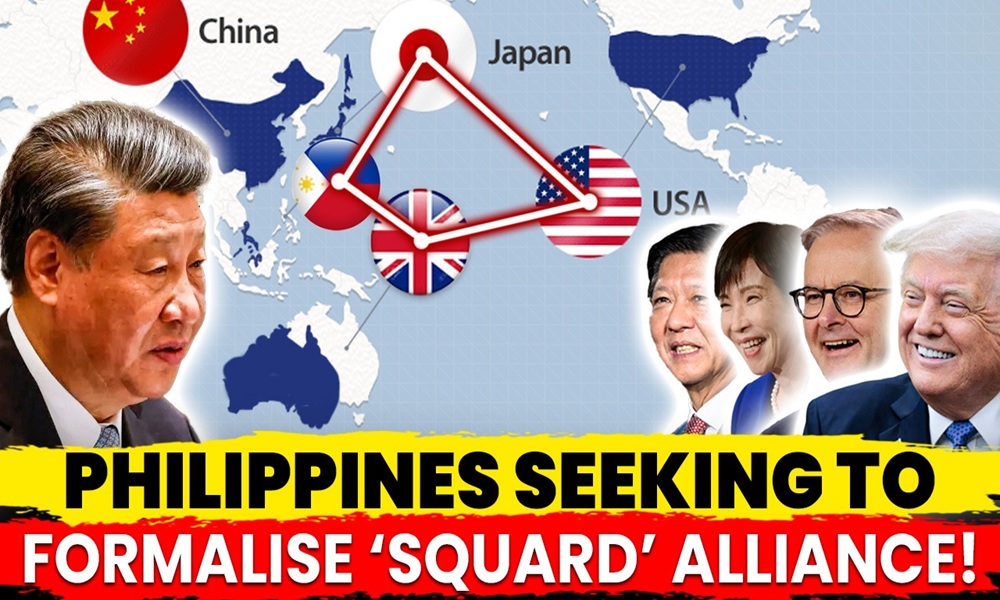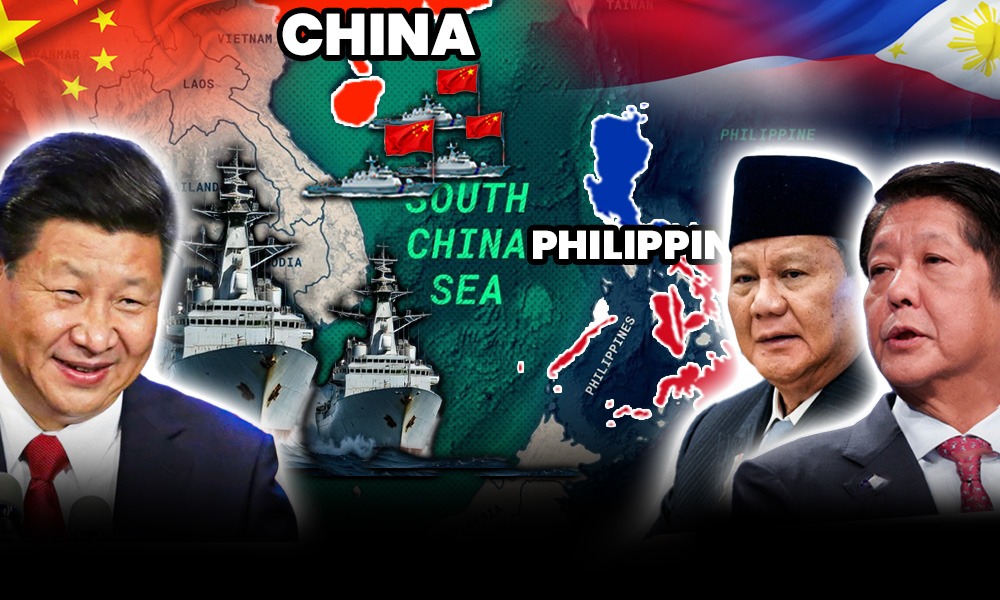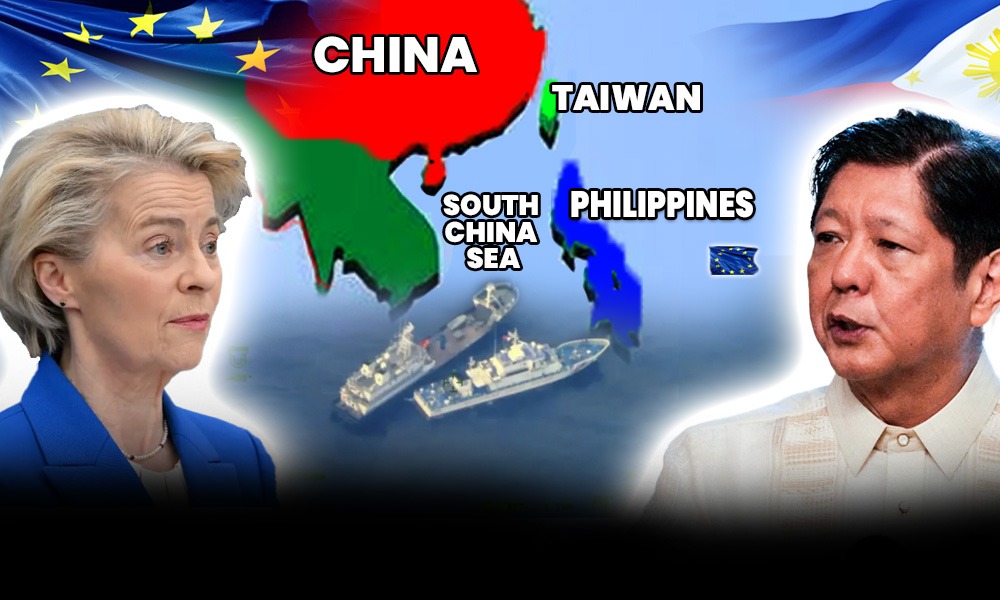Philippines seeking to formalise the ‘Squad’ alliance with its partners
For decades, the Philippines’ security architecture rested almost entirely on its alliance with the United States, anchored by the 1951 Mutual Defense Treaty (MDT) and sustained through the Visiting Forces Agreement (VFA) and Enhanced Defense Cooperation Agreement (EDCA). Yet, under President Ferdinand Marcos Jr., Manila has begun a decisive shift toward diversification, seeking broader regional partnerships and multilateral defense cooperation in response to what it calls China’s unrelenting aggression in the West Philippine Sea. This transformation reflects a more outward-looking and proactive security posture, one that recognizes the limitations of bilateral dependency and the necessity of shared deterrence across the Indo-Pacific.
Against this backdrop, the Philippines has joined Australia, Japan, and the United States in the informal “Squad” alliance, an emerging minilateral security framework dedicated to enhancing joint patrols, intelligence sharing, and coordinated military operations in the region. The growing institutional weight of this grouping, marked by defense chiefs’ meetings in 2023 and 2025, illustrates a strategic evolution from flexible cooperation to structured alignment. The rationale for formalizing the Squad is clear: to counter coercive behavior, strengthen deterrence, and close the Philippines’ capability gap through collective defense. Manila sees the alliance as a means to offset its limited defense budget, which has historically averaged only 1.5% of GDP, and to synchronize modernization efforts with its partners’ advanced capabilities.
The pathways toward formalization are unfolding through a multi-pronged strategy. First, the Philippines seeks to expand the network to include like-minded partners such as India, which shares its concerns about China and potentially South Korea, though Seoul’s economic ties to Beijing pose challenges. Second, Manila is constructing a legal foundation through bilateral and trilateral frameworks, including new Status of Visiting Forces Agreements (SOVFAs) with Canada and negotiations with France and the United Kingdom. Third, there are early discussions of transforming the Squad into a formal “Pacific Defense Pact,” a collective defense mechanism akin to NATO’s model, that would institutionalize commitments among key Indo-Pacific democracies.
However, the path to formalization is fraught with geopolitical and economic challenges. China has voiced sharp opposition, denouncing the Squad’s activities, such as the deployment of U.S. missile systems in the Philippines, as part of a Western effort to “tighten the noose” around its regional influence. The move also risks unsettling ASEAN norms of neutrality and consensus, which could exacerbate divisions within Southeast Asia. Economically, the Philippines remains deeply tied to China, which remains one of its largest trade and investment partners. Formalizing an explicitly anti-China security framework therefore forces Manila to balance its economic interdependence with its security imperatives, a delicate act that tests both strategic coherence and political will.
Despite these complexities, the future of the Squad appears increasingly pivotal to the Philippines’ strategic trajectory. By leveraging its geography, astride key maritime routes linking the Pacific and South China Sea and its status as Washington’s oldest treaty ally in Southeast Asia, the Philippines is positioning itself as a central node in a “web of deterrence.” The transition from an inward counterinsurgency focus to an external defense orientation, exemplified by the Comprehensive Archipelagic Defense Concept, shows the necessity of formalized alliances in sustaining long-term deterrence. As Defense Secretary Gilberto Teodoro emphasized, the grouping aspires to be “not an exclusionary alliance, but an inclusive and transparent framework” grounded in international law and the global rules-based order.
The Philippines’ pursuit of Squad formalization represents more than just an alignment of militaries, it is a redefinition of Manila’s strategic identity. By weaving itself into a multilateral fabric of like-minded partners, the Philippines seeks not only to secure its sovereignty but also to assert its place as an active shaper of Indo-Pacific stability in an increasingly contested maritime domain.
The Rationale for Formalization: Countering Coercion and Boosting Deterrence
The Philippines’ intensifying push to formalize the emerging “Squad” alliance stems from its urgent need to strengthen deterrence and strategic resilience amid escalating maritime tensions and long-standing defense limitations. This drive reflects a fundamental recalibration of Manila’s national security priorities: from reliance on ad hoc or bilateral defense arrangements toward a structured multilateral security architecture that can collectively respond to coercive challenges in the Indo-Pacific. The shift is underpinned by the Marcos Jr. administration’s recognition that a fragmented or purely bilateral approach to external defense is insufficient in the face of growing regional volatility and the increasing assertiveness of the People’s Republic of China (PRC) in maritime disputes.
At the core of this rationale lies the Philippines’ direct confrontation with China’s expanding maritime and paramilitary activities in the West Philippine Sea. Over the past decade, China has entrenched a network of militarized artificial islands, supported by coast guard and maritime militia vessels that operate well within the Philippines’ Exclusive Economic Zone (EEZ). The Philippine government has repeatedly accused Beijing of engaging in “illegal, coercive, and disruptive grey-zone tactics” actions that fall below the threshold of armed conflict yet systematically undermine Manila’s sovereignty and international maritime law. As Armed Forces of the Philippines (AFP) Chief of Staff Gen. Romeo Brawner Jr. declared in 2025, “we are not afraid to say that China is our common enemy,” a stark statement that captures the growing willingness of Philippine defense leaders to frame China as a strategic adversary rather than merely a disputant.
The Philippines’ position has been particularly tested at flashpoints such as the Second Thomas Shoal (Ayungin Shoal), where a small contingent of Filipino marines stationed aboard the grounded BRP Sierra Madre have faced repeated harassment from Chinese coast guard vessels attempting to block resupply operations. These confrontations, often involving high-pressure water cannoning, dangerous maneuvers, and maritime blockades have come to symbolize the daily realities of Chinese coercion and the inadequacy of unilateral responses. Consequently, Manila views the Squad, an informal grouping with the United States, Japan, and Australia, as a mechanism to pool resources, share intelligence, and collectively signal resolve.
The Squad’s joint Maritime Cooperative Activities (MCAs), including the most recent exercise in February 2025 within the Philippines’ EEZ, embody this operational solidarity. These joint patrols, often featuring advanced surface combatants, reconnaissance aircraft, and coordinated information-sharing networks, serve a dual purpose: reinforcing deterrence through visible multilateral presence and enhancing interoperability among allied forces. The Philippines, long constrained by limited maritime capabilities, thus leverages the presence of its partners to amplify its defensive reach and credibility. By aligning its security posture with three major Indo-Pacific democracies, Manila strengthens both deterrence and its claim to maritime legitimacy under the United Nations Convention on the Law of the Sea (UNCLOS).
Philippines Expands Patrol Zone in West Philippine Sea | China Shocked!
Yet beyond the external challenge posed by China, Manila’s rationale for formalizing the Squad is also rooted in enduring structural weaknesses within its defense establishment. From 1987 to 2024, Philippine defense spending averaged a modest 1.5 percent of GDP, far below the NATO benchmark of 2 percent commonly associated with credible defense readiness. This chronic underinvestment has left the Armed Forces of the Philippines (AFP) dependent on foreign aid, outdated platforms, and constrained logistical capacity. Historically, much of the defense budget has been devoted to internal security missions, counterinsurgency campaigns against communist rebels and Islamist extremists, rather than external deterrence or modernization of the navy and air force. This inward focus left critical maritime and aerospace domains under-resourced even as regional threats intensified.
Consequently, analysts and policymakers alike have questioned whether “alliances and diplomacy can offset [the Philippines’] continued underinvestment in defense.” For the Marcos administration, formalizing the Squad offers a pragmatic answer: by embedding the Philippines within a structured multilateral defense network, it can compensate for fiscal and technological deficits through burden-sharing, joint training, logistics integration, and access to advanced capabilities from its more developed partners. The alliance also serves as a platform for the synchronization of defense investments, such as the modernization of the Philippine Navy’s offshore patrol vessels and the establishment of new EDCA sites for interoperability with U.S. and allied forces.
In this sense, the push toward formal institutionalization is not merely symbolic but strategically functional. It allows the Philippines to project deterrence disproportionate to its size and resources, strengthen defense industrial linkages, and enhance maritime domain awareness across the Indo-Pacific. For a country long caught between economic dependence on China and security reliance on the United States, the Squad’s formalization represents both a strategic hedge and a force multiplier, a pragmatic mechanism to close the capability gap and preserve its sovereignty amid a rapidly evolving regional order.
Ukraine’s Combat UAV Steals the Show at Philippines Defense Exhibition
Pathways and Mechanisms for Formalizing the Alliance
The Philippines’ effort to formalize the informal “Squad” security grouping is unfolding along several converging pathways that blend diplomatic outreach, institutional consolidation, and strategic vision. At its core, the move reflects Manila’s determination to elevate an ad hoc minilateral framework into a structured, rules-based security mechanism capable of delivering tangible deterrence and collective action.
A central pathway involves the expansion of the Squad’s membership to include other like-minded partners that share similar threat perceptions and strategic priorities. In March 2025, Armed Forces of the Philippines (AFP) Chief Gen. Romeo Brawner Jr. confirmed that Manila was “trying to expand the Squad to include India and probably South Korea.” This announcement signaled a deliberate shift from a narrowly defined quadrilateral to a potentially broader Indo-Pacific coalition. As Brawner explained, “We find commonality with India because we have a common enemy,” highlighting Manila’s view that New Delhi’s own border tensions and rivalry with Beijing make it a natural partner in countering Chinese coercion. India’s long-standing advocacy of freedom of navigation and its active role in the Quad (with the U.S., Japan, and Australia) further align it with the Squad’s objectives.
However, the prospect of South Korea’s inclusion introduces complexity. Seoul maintains deep economic interdependence with China, its largest trading partner and remains cautious about overtly joining initiatives perceived as anti-China in nature. South Korea’s foreign policy traditionally favors a balanced approach that safeguards its economic interests while maintaining its security alliance with the United States. Hence, while India’s participation appears strategically aligned, Seoul’s potential involvement is constrained by its need to navigate between economic pragmatism and geopolitical loyalty. This contrast shows the broader challenge of expanding the Squad’s membership without alienating partners who remain wary of formalized blocs that might exacerbate regional polarization.
The second pathway toward formalization lies in the development of legal and institutional frameworks that can serve as the building blocks of a multilateral defense arrangement. The Philippines is leveraging existing bilateral and trilateral agreements to create a lattice of compatible defense mechanisms. A key milestone in this process was the strengthening of the Philippines–U.S.–Japan trilateral framework, which achieved formal consolidation during the Washington summit in April 2024. This trilateral has expanded cooperation in joint maritime patrols, logistics support, and defense technology sharing, forming the institutional nucleus from which the Squad could evolve.
Parallel to this, the Philippines has expanded its network of Status of Visiting Forces Agreements (SOVFAs) and defense cooperation frameworks with other partners. The signing of a SOVFA with Canada in November 2025 and ongoing negotiations with France and the United Kingdom for similar agreements reflect Manila’s commitment to a multi-vector defense diplomacy. These agreements not only grant reciprocal access for military forces but also embed the Philippines within a wider web of interoperable partnerships, thereby deepening its strategic flexibility and resilience. The outreach to European partners indicates that the Philippines envisions its defense modernization as part of a global, not merely regional, framework of cooperation grounded in shared democratic values and respect for international law.
A third and more ambitious pathway is the exploration of a formal collective defense pact modeled on existing multilateral alliances. Former U.S. defense official Ely Ratner proposed the idea of a “Pacific Defense Pact,” which would institutionalize defense commitments among the countries “most aligned and prepared to take on the China challenge together, Australia, Japan, the Philippines, and the United States.” This vision mirrors the collective deterrence logic of NATO but adapted to the Indo-Pacific’s decentralized security environment. While the proposal remains conceptual, it illustrates Washington’s growing interest in building a structured defense architecture that integrates multiple minilaterals including the Squad, into a coherent deterrence framework.
For Manila, formalizing such a pact could provide long-term strategic dividends: guaranteed defense cooperation, enhanced access to advanced military technologies, and a formalized mechanism for joint operational planning. However, such an arrangement also carries potential costs, including the risk of heightened Chinese retaliation, dependency on U.S.-led defense planning, and tension with ASEAN’s principle of non-alignment.
In sum, the Philippines’ strategy for formalization rests on three intertwined pillars: expansion of membership, legal-institutional consolidation, and exploration of a broader collective defense framework. These pathways collectively aim to transform the Squad from an informal coalition into a structured, interoperable defense mechanism anchored in shared threat perceptions and mutual commitments. Yet the success of this transformation will hinge on Manila’s ability to balance inclusivity with cohesion, navigate the geopolitical sensitivities of regional partners, and manage the inevitable diplomatic pushback from Beijing, all while ensuring that its new partnerships strengthen, rather than constrain, its strategic autonomy.
France to Supply 40 Fast Patrol Boats for the Philippines to Defend the West Philippine Sea
Challenges and Implications of Formalization
The formalisation of the informal “Squad” alliance by the Philippines carries a number of geopolitical and normative risks. Beijing has repeatedly signalled displeasure at enhanced U.S. military presence and closer Philippine-allied cooperation. For example, Chinese commentary has criticised the deployment of the U.S. Typhon missile system in the Philippines and the prospect of tighter access agreements with Tokyo and Manila, viewing them as a strategy to “tighten the noose” around China’s regional options. At the same time, the region’s normative framework, particularly that embodied by ASEAN, emphasises non-alignment, minimal external entanglements, and consensus-based diplomacy. Critics argue that the rise of minilaterals like the Squad risks “upending ASEAN norms” by shifting away from inclusive multilateral frameworks toward exclusive, binding defence-oriented alignments. The institutional weakness of ASEAN (notably its lack of binding collective-security mechanisms) is frequently cited as a “barrier to progress” when trying to build region-wide security architectures and the Philippines’ engagement in a more formalised alliance could heighten tensions between individual member states’ bilateral security relationships and the broader regional ethos.
Beyond normative and geopolitical friction, the Philippines faces significant economic trade-offs tied to its growing alignment with the United States, Japan and Australia. China remains a major economic partner: while the exact figures you quoted (exports $1.04 billion, investment $3.2 billion for the 2017-21 period) are not perfectly mirrored in publicly accessible sources, available data confirms that bilateral trade and investment flows are substantial. For example, China exported about US$52.4 billion of goods to the Philippines in 2023 and the Philippines exported around US$10.65 billion to China. Imports from China accounted for some 20.6 % of Philippine imports in 2022. Beijing’s development financing in the Philippines between 2000-22 is estimated at US$9.1 billion.
Philippines Just Admitted It Might Fight China Alone — For 30 Days
In practice this means that the Philippines, by moving to formalise a more overt defence alignment opposed in large part to Chinese maritime and security interests, risks economic retaliation, reduction in Chinese investment, supply-chain disruptions or diplomatic/economic push-back from Beijing. Given Manila’s strategic objective to diversify defence partners and boost deterrence, it must still manage the reality that its economy remains deeply intertwined with China. Analysts warn that for the Philippines, the challenge is whether “alliances and diplomacy can offset its continued under-investment in defence,” while also protecting its economic lifelines. This balancing act is complicated further by regional competitors who may capitalise on any economic strain felt by Manila.
In short: the formalisation of the Squad may strengthen deterrence and institutionalise security partnerships, but it also brings increased exposure to geopolitical push-back, normative friction with ASEAN’s established security culture, and the risk of economic vulnerabilities given the Philippines’ sustained trade and investment linkages with China.
Conclusion: The Future of the ‘Squad’
The Philippines is leveraging its strategic location and its status as the United States’ oldest treaty ally in Southeast Asia to become the central node in a growing “web of deterrence” embedding itself at the heart of a network of regional and extra-regional partners to bolster maritime and territorial defence. According to commentary, this emerging posture reflects Manila’s shift from purely bilateral arrangements to a broader multilateral matrix of security cooperation.
Looking ahead, the Philippines’ transition from an inward focus on internal security to an external defence posture, encapsulated in the Comprehensive Archipelagic Defence Concept, makes the formalisation of broader multilateral security frameworks increasingly necessary for effective deterrence. Reflecting this inclusive outlook, Philippine Defence Secretary Gilberto Teodoro emphasised that the grouping is “not an exclusionary grouping, but an inclusive one with an open and transparent architecture on the basis of global order, based on international law.”
In effect, the formalisation of the “Squad” offers Manila a calibrated way to reinforce its defence posture, secure deeper commitment from key partners, and project collective deterrence without abandoning its broader diplomatic space. The balance Manila must strike now is how to institutionalise its partnerships in a way that deepens security cooperation, preserves operational flexibility, and remains consistent with international law and regional norms.



